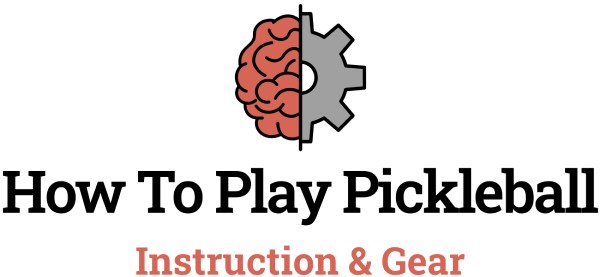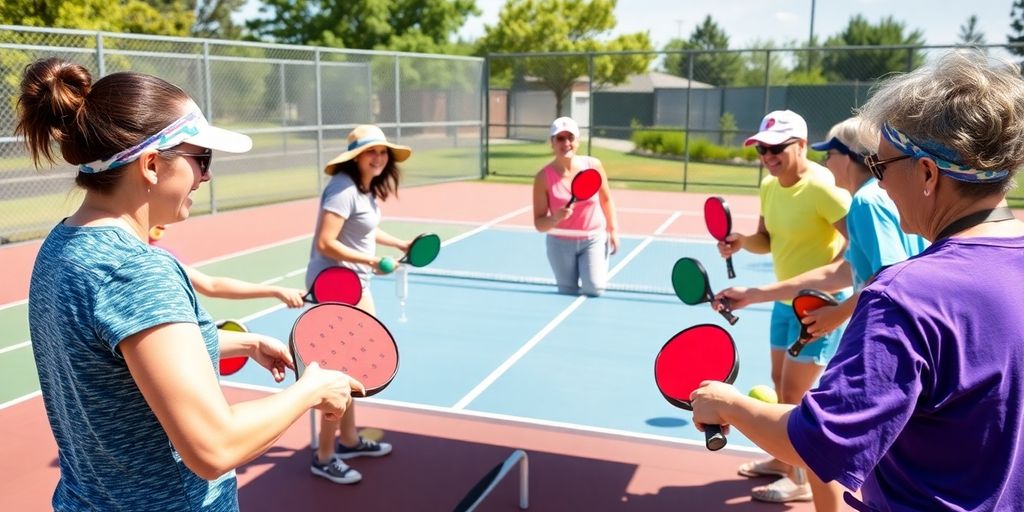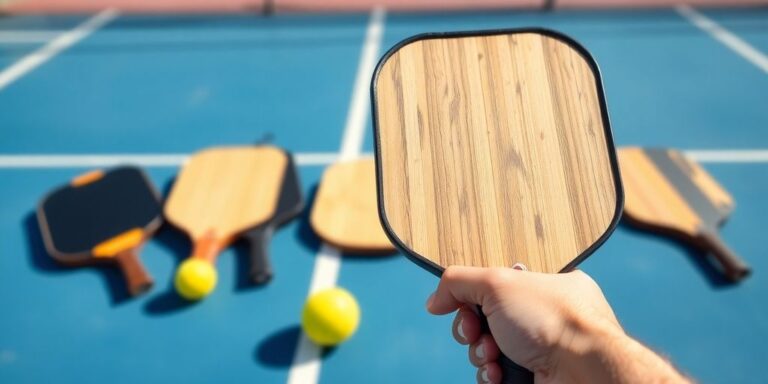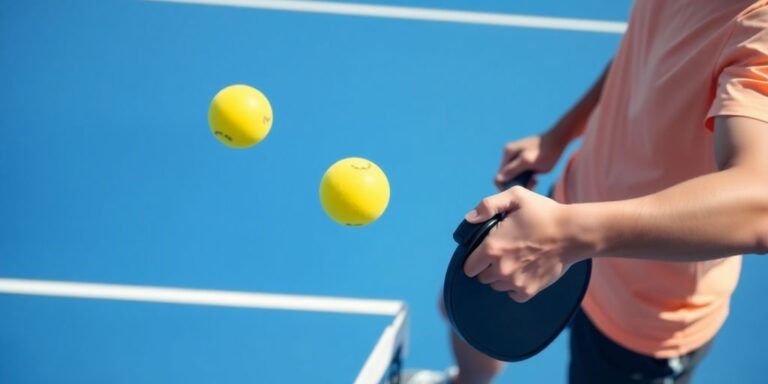Pickleball is catching on like wildfire, and for good reason. It’s easy to learn, fun to play, and a great way to stay active. Whether you’re young or just young at heart, diving into pickleball can be a rewarding experience. In this guide, we’ll break down the basics, teach you some cool techniques, and help you find the right gear and community to get started. Let’s get those paddles moving and have some fun!
Key Takeaways
- Pickleball is a simple yet engaging game suitable for all ages.
- Understanding the court and rules is essential for beginners.
- Mastering basic techniques like serving and volleying can enhance your game.
- Choosing the right gear, like paddles and balls, can improve your play.
- Joining a local pickleball community can boost your skills and enjoyment.
Understanding the Basics of Pickleball
The Court and Equipment Essentials
Pickleball is a sport that combines elements of tennis, badminton, and ping pong, played on a smaller court with a paddle and a plastic ball. The court is 20 feet wide and 44 feet long, divided by a net in the middle. You’ll need a paddle, which is slightly larger than a ping pong paddle, and a perforated plastic ball similar to a wiffle ball. Choosing the right equipment is crucial for comfort and performance on the court. Don’t forget to wear comfortable athletic wear and court shoes to prevent slipping.
Basic Rules and Scoring System
The game starts with an underhand serve from the right side of the court. The ball must bounce once on each side before players can volley it in the air. This is known as the "two-bounce rule." Points are scored only by the serving team, and games are typically played to 11 points, but a team must win by at least 2 points. Remember, you can’t stand in the "kitchen," a 7-foot non-volley zone near the net, when hitting a volley.
Safety Tips for Beginners
Playing pickleball is fun, but safety should always come first. Here are some tips to keep in mind:
- Warm up before playing to prevent injuries.
- Stay hydrated to maintain energy levels.
- Wear proper footwear to avoid slips and falls.
Pickleball is not just about the game; it’s about enjoying the experience and staying safe while doing so. Follow these tips to ensure you have a great time on the court.
Mastering Pickleball Techniques

Developing Your Serve and Return
The serve is your first chance to set the tone of the game. Nailing a consistent serve can give you a significant advantage. Focus on developing a routine that you can rely on, whether you’re aiming for power or precision. When it comes to returns, the key is to stay calm and focused. Try to gauge the speed and spin of the incoming ball and adjust your stance accordingly. Here’s a simple routine to practice:
- Start with 10 serves aiming for different parts of the service box.
- Practice returning serves by having a partner serve to you, focusing on different types of spins.
- Record your practice sessions to analyze your form and improve.
Perfecting Groundstrokes and Volleys
Groundstrokes form the backbone of your rally game. Work on both forehand and backhand shots to keep your opponents guessing. Keep your eye on the ball and your feet moving; this helps in maintaining balance and control. Volleys, on the other hand, are all about timing and positioning. Try to hit the ball before it bounces, which requires quick reflexes and good anticipation. Here’s a quick drill:
- Set up a target on the court and aim for it with your groundstrokes.
- Practice volleys by standing close to the net and having a partner feed balls to you.
- Focus on your grip and swing path to ensure consistency.
Learning the Art of Dinking
Dinking is an essential skill in pickleball, especially when you’re at the kitchen line. This soft shot can disrupt your opponent’s rhythm and create opportunities for you to attack. Practice using a gentle touch to keep the ball low and just over the net. Remember, patience is key here. You want to wait for the perfect moment to make a more aggressive shot. Here’s how to get better at dinking:
- Start with simple dinks, aiming just over the net.
- Gradually increase the complexity by adding spins and angles.
- Pair up with a partner and engage in dink-only rallies to sharpen your skills.
Pickleball is not just about power; it’s about finesse and strategy. Mastering these techniques will not only make you a better player but also increase your enjoyment of the game.
Building a Strong Foundation in Pickleball
Importance of Footwork and Positioning
Footwork and positioning are the unsung heroes of a solid pickleball game. As you start, remember that good footwork can make or break your play. It’s all about being in the right spot at the right time. Try these basics:
- Stay on your toes to move quickly.
- Keep your knees slightly bent for better balance.
- Always return to the center of the court after a shot.
By practicing these steps, you’ll find yourself reaching for fewer shots and playing more confidently.
Effective Communication with Your Partner
Playing doubles? Then communication is key. You and your partner should be on the same page, or you’ll end up stepping on each other’s toes—literally.
- Call out "mine" or "yours" to avoid confusion.
- Discuss strategies before matches.
- Encourage each other during play.
Remember, a team that communicates well often wins more games.
Strategies for Beginners
Starting out can be overwhelming, but having a few strategies up your sleeve will help. Focus on these beginner-friendly tactics:
- Serve with consistency: Aim for a steady serve rather than a powerful one.
- Master the dink: It’s a soft shot that keeps your opponent on their toes.
- Stay patient: Wait for the right moment to attack.
Building a strong foundation in pickleball is not just about skills; it’s about understanding the game, communicating effectively, and having fun. With beginner pickleball tips and strategies, you can enhance your game step by step.
By keeping these tips in mind, you’ll not only improve your game but also enjoy every moment on the court.
Exploring Pickleball Drills and Exercises
Warm-Up Routines for All Ages
Before you even think about hitting the court, warming up is a must. It’s like setting the stage for a great game. A good warm-up gets your muscles ready and helps prevent injuries. Start with some light jogging or brisk walking around the court to get your blood flowing. Follow this up with dynamic stretches, like arm circles and leg swings, to loosen up those joints. Finish with a few minutes of shadowing your shots—just mimicking the movements without the ball.
Skill-Building Drills for Beginners
Getting the hang of pickleball takes practice, and these drills are here to help. Try the 7-11 drill to sharpen your accuracy and decision-making. Focus on hand-eye coordination by practicing volleys against a wall or with a partner. Groundstroke drills are also key—set up targets on the court and aim to hit them consistently. These exercises are not just about skill—they’re about building confidence on the court.
Cool-Down Techniques to Prevent Injuries
After an intense game, cooling down is just as important as warming up. It helps your body transition back to rest. Start with some gentle walking to lower your heart rate. Then, move into static stretches, focusing on major muscle groups like quads, hamstrings, and shoulders. Deep breathing exercises can also help relax your body and mind. Remember, taking care of your body post-game keeps you ready for the next match.
Choosing the Right Pickleball Gear
Selecting the Best Paddle for Beginners
Getting the right paddle is like finding the perfect pair of shoes; it can make or break your game. For beginners, you want something lightweight yet sturdy. Fiberglass paddles are often recommended because they offer a good balance of power and control. When you’re just starting, you don’t need the fanciest paddle out there. Focus on comfort and grip. Check out the top 6 pickleball paddles for beginners to find one that suits you.
Understanding Different Types of Balls
Pickleball balls come in two main types: indoor and outdoor. The difference lies in the weight and the size of the holes. Outdoor balls are heavier and have smaller holes to withstand wind. Indoor balls are lighter with larger holes. It’s essential to choose the right ball for your playing environment to ensure a good game.
| Type | Weight | Hole Size | Best For |
|---|---|---|---|
| Indoor | Light | Large | Indoor play |
| Outdoor | Heavy | Small | Outdoor play |
Essential Clothing and Accessories
When it comes to clothing, comfort is king. Wear breathable sportswear that allows for easy movement. Shoes are critical; opt for ones with good grip and support. Proper attire not only helps you move better but also keeps you safe on the court. Don’t forget accessories like sweatbands and hats for those long matches under the sun.
Investing in the right gear from the start can make your pickleball experience more enjoyable and efficient. You don’t have to break the bank, but choosing wisely will set you up for success on the court.
Finding the Perfect Pickleball Coach

Qualities to Look for in a Coach
When you’re on the hunt for a pickleball coach, it’s like finding a good pair of shoes—you want the right fit. A great coach should be patient, knowledgeable, and encouraging. They should have a knack for explaining techniques in a way that clicks with you. Look for someone who tailors their teaching style to your learning pace and skill level.
- Experience and Credentials: Check their background. Have they played professionally or coached for years?
- Communication Skills: Can they break down complex moves into simple steps?
- Availability: Make sure their schedule aligns with yours.
Benefits of Private vs. Group Lessons
Choosing between private and group lessons depends on your personal goals and learning style. Private lessons offer one-on-one attention, which can be great if you’re looking to master specific skills. On the other hand, group lessons can be more fun and social, providing a chance to meet fellow players.
- Private Lessons: Customized to your needs, faster progress, more expensive.
- Group Lessons: Cost-effective, social interaction, less individual focus.
How to Evaluate a Coach’s Experience
Evaluating a coach’s experience isn’t just about the number of years they’ve been coaching. It’s about the quality of those years.
- Ask for Testimonials: Previous students can give you insight into the coach’s teaching style and effectiveness.
- Observe a Lesson: Watch them in action. Are they attentive and engaging?
- Trial Lesson: Some coaches offer a first lesson free or at a reduced rate. Use this opportunity to see if their style suits you.
Finding the right coach might take some time, but it’s worth it. A good coach can make all the difference in your pickleball journey, helping you to not only learn the game but also to enjoy it to the fullest.
Joining a Pickleball Community
Finding Local Pickleball Clubs
Getting into pickleball is a lot more fun when you’re part of a community. Finding a local club is your first step. Most towns have clubs where beginners are always welcome. You can usually find these clubs by asking around at your local sports centers, checking community boards, or doing a quick online search. Many clubs offer beginner-friendly sessions, so you can learn and play without feeling overwhelmed. Being part of a club not only improves your game but also introduces you to new friends who share your interest.
Participating in Pickleball Tournaments
Once you’ve got the basics down, participating in tournaments can be a thrilling experience. Tournaments aren’t just for seasoned players; there are often brackets for beginners too. Start by signing up for local events to get a feel of competitive play.
- Local Tournaments: Great for beginners, often organized by local clubs.
- Regional Competitions: A bit more competitive, but a fantastic way to test your skills.
- National Events: For those who are really serious about the sport.
Remember, tournaments are not just about winning but about enjoying the game and learning from each match.
Social Benefits of Playing Pickleball
Playing pickleball isn’t just about the game itself; it’s also about the social connections you make. Whether you’re playing doubles or just hanging out after a match, pickleball offers a chance to meet people from different walks of life. The sport is known for its welcoming and inclusive atmosphere, making it easy to strike up conversations and build friendships.
Pickleball is more than just a sport; it’s a community where everyone is welcome, and every game is a chance to connect and have fun.
For anyone looking to enhance their pickleball experience, joining a community is a great way to combine both learning and socializing. It’s not just about the game; it’s about the people you meet along the way.
Becoming part of a pickleball community can really boost your game and make it more fun! You’ll meet new friends, learn from others, and share tips that can help you improve. Don’t miss out on the chance to connect with fellow players and grow together. Check out our website to join Nunnery’s Pickleball Lab and start your journey today!
Conclusion
Pickleball is more than just a game; it’s a way to connect with others and have a blast while staying active. Whether you’re young or just young at heart, the basics of pickleball are easy to pick up, making it perfect for everyone. As you dive into the world of pickleball, remember that practice makes perfect, and the joy is in the journey. So grab a paddle, hit the court, and enjoy every moment of learning and playing. Who knows, you might just find your new favorite hobby!
Frequently Asked Questions
What is pickleball, and how do you play it?
Pickleball is a fun game that combines elements of tennis, badminton, and ping-pong. You play it on a court with a net, using paddles to hit a perforated ball. The goal is to score points by hitting the ball in such a way that your opponent cannot return it.
What equipment do I need to start playing pickleball?
To get started with pickleball, you’ll need a paddle, a pickleball (which looks like a wiffle ball), and a court with a net. Some players also like to wear comfortable athletic clothing and shoes.
Can people of all ages play pickleball?
Yes, pickleball is a great sport for people of all ages. It’s easy to learn and can be played at a pace that suits your fitness level, making it perfect for families and friends to enjoy together.
How do you keep score in pickleball?
In pickleball, games are usually played to 11 points, and you must win by at least 2 points. Only the serving team can score points. The game starts with a serve, and players take turns hitting the ball until someone misses.
What are some basic safety tips for playing pickleball?
To stay safe while playing pickleball, always warm up before starting, wear proper shoes to avoid slipping, and keep hydrated. Also, be mindful of your surroundings to avoid collisions with other players.
How can I find a pickleball coach or community near me?
You can find a pickleball coach or community by searching online for local clubs or community centers that offer lessons. Joining a pickleball group on social media can also help you connect with other players in your area.




